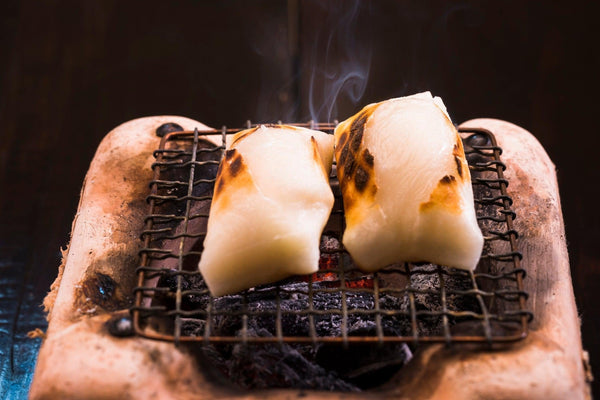
Jump to:
Mochi is really popular in the West these days, but have you heard of kirimochi? Kirimochi (sometimes two words, kiri mochi) is popular in Japanese households for its flexibility. It can be used in many different dishes, the portions are controlled (each piece is individually wrapped), it has a long shelf life and it tastes great! This article will talk about what kirimochi is, a bit about its history, how to prepare it, and more.
What Is Kirimochi?

Well, to understand kirimochi, we first need to understand mochi. Mochi (some translate it as a Japanese “rice cake”) is traditionally made by pounding rice with a mallet until it gets that gooey, almost gelatinous texture it’s known for. Chances are you’ve tried it by now because it’s pretty easy to find in the West. And although people overseas associate it with sweet foods like ice cream mochi and sweet mochi snacks, it’s actually eaten as a savory food in Japan, as well.
Now about the kirimochi — yes, it is indeed a form of mochi. And what makes it unique is that it’s cut up into pieces (the kiri in kirmochi actually means “cut”) and packaged in dry form. Because it’s dried and packaged, it has a longer shelf life than fresh mochi. It’s also easier to make just as much as you need, because each slice is separated into individually wrapped portions (sorry for all the plastic, environment — but at least this one makes sense).
The Ingredients Of Kirimochi

Kirimochi, just like regular mochi, is made from one simple ingredient: glutinous rice (called mochigome in Japanese). This is not the rice that’s used in sushi — that’s called uruchimai. Both rices are similar, but glutinous rice is more often used in sweeter foods. Uruchimai is eaten as regular rice served with daily meals and most cooking. Fun fact: glutinous rice doesn’t contain gluten.
The History Of Kirimochi
To know the history of kirimochi, we first need to know a bit about the history of mochi. The earliest written account we have of mochi existing in Japan is from the Nara period (710-784) in an ancient book called Bungo no Kuni Fudoki. But most people think that mochi came to Japan even earlier than that — from Southeast Asia — around the same time as rice cultivation techniques were incorporated into Japanese farming.
Apparently, mochi used to be made with a more reddish-colored rice. The round rice cakes of that day were likely much larger than they are now, as well. On a spiritual level, Japanese people associated mochi with good luck, long life, and a connection with the gods — especially around the New Year. More on that later.
So, what about the history of kirimochi? Well, it came along in the 20th century. In the early 1900s mochi was already being mass-produced and sold in Japan, but it was not yet what we know as kirimochi. It was prepackaged, but it had a problem with molding easily. Fortunately, a new packaging and sterilization method was developed that prevented this molding in 1964.
A company called Sato Foods thought they could use this method to make and sell their mochi — and they did. It was a success, and was the beginning of what would be called “Sato no Kirimochi.” It evolved in shape and packaging over time, but it became perhaps the most popular cut and dried mochi on the market. If you want more details on Sato no Kirimochi’s history, check out this article by NTT Comzine (in Japanese).
The Significance Of Mochi In Japanese Culture

People in Japan eat mochi (including kirimochi) all year long, but it’s eaten a lot more around New Year’s. Why is that? According to the Kyoto Confectionery and Bakery Technical College, eating mochi at New Year’s is a way to bring prosperity to you and your family for the year — kind of like American Southerners eating greens and black-eyed peas.
One particular type of mochi is particular to the New Year’s holiday in Japan, though — kagami mochi. It started as an offering to a god (Toshigami) way back when (but in modern Japanese culture who can say where the tradition begins and the spirituality ends). Kagami mochi is made by placing two rice cakes (mochi) on top of one another. The cake on the bottom is wider than the one on top. Some call it a “mirror” rice cake.
There are decorations on kagami mochi, too — often a small bitter orange (called daidai) on top along with leaves, small fans or whatever is popular locally. This type of mochi gets really dry (on purpose), because after the New Years celebrations you break or crack it open. This is to avoid cutting it (because using a knife could “cut” spiritual connections with the god of the New Year).
How To Cook Kirimochi

One of the great things about kirimochi is how easy it is to make. You can toast it in a toaster oven, grill it in a pan, boil it in water, or even microwave it. Here are the most popular ways to prepare it.
- Grilling - Just put the kirimochi in a pan on your stovetop. It will get crispy on the outside and chewy-gooey on the inside. Just grill each side until they become slightly browned and puffy. This style of mochi is also known as yaki mochi. Take a look at this video by StirCozy to see the grilling method in action.
- Toasting - A toaster oven may be the most popular way to make kirimochi in Japan — just because it’s quick, easy and tasty. If you have a toaster oven, you can put the rice cakes on a piece of foil (on a baking tray or right on the rack) and toast them until they puff up and turn slightly golden. Make sure to turn them halfway through to get them crispy on both sides!
- Microwaving - This way is quick and easy, too, but be warned that the mochi gets really soft. This isn’t the way to go if you want it crispy, but it works well for softer, gooey mochi.
- Boiling - Yes, you can even boil kirimochi! You would use this method for things like soup or oden mostly. Just boil your stock or water in a pot, set it to simmer and pop in the kirimochi.
Ingredients That Go Well With Kirimochi

Kirimochi can be eaten in so many different ways and in so many different dishes — both sweet and savory. Here are a few things you might want to try with your mochi.
- Azuki Red Bean Paste (anko) - It's most commonly served with mochi in the form of daifuku, but you can eat it with kirimochi by just putting the anko on top of the mochi after you cook it.
- Grated White Radish (daikon) - This gigantic radish has a nice mild flavor if you’re looking for a fresh and healthy topping. The daikon is usually grated finely until it has a consistency of something like applesauce (but not the taste of applesauce).
- Roasted Soybean Flour (kinako) - This is a sweeter option, just don’t forget to add a little sugar to the kinako to make it taste right. Take a look at our warabi mochi recipe for kinako ideas.
- Soy Sauce - You can use standard soy sauce (shoyu) or sweet soy sauce (amakuchi shoyu) — it all depends on your preference.
- Sesame Paste (nerigoma) - There are two versions of this paste — white and black. The white sesame is more sweet and creamy, while black sesame has some bitterness.
- Seaweed Paste (nori tsukudani) - This paste is made from seaweed and a few other ingredients and has a sweet and umami flavor.
- Nori (seaweed) - Usually wrapped around the kirimochi, but you can be creative.
- Honey - What doesn’t taste good with honey? Seriously trying to think of something…
- Jam - Another sweeter option — just pick your favorite jam and top your kirimochi with it.
Dishes You Can Use Kirimochi In

There are tons of dishes you can make with kirimochi. You can make traditional meals like oden and sukiyaki or get creative with dishes like mochi gratin or mochi gyoza. There are some great recipes out there using mochi, and some of them are right here on Japanese Taste! Here are a few you might want to try.
Note: Even if “kirimochi” isn’t listed directly in the recipe, you can use it where mochi is called for (kirimochi is mochi!).
- Ozoni - This is a New Year’s soup, so of course mochi is in it! You can put all kinds of ingredients into this dashi-based brew, but some common ones are chicken, carrots, greens and, of course, mochi. Here’s a good recipe for it.
- Oden - This delicious soup-like dish is popular in the winter in Japan — it’s recognizable by its big chunks of daikon, boiled eggs and, yes, mochi! You’ll even see this being served fresh on the counter at convenience stores in the winter season. Here’s a recipe for a Kyoto version of oden.
- Zenzai or Oshiruko - A sweet red bean (azuki) soup served with mochi. This one is popular in the winter and New Year, too. Some people even eat it with kagami mochi. It can be served hot or cold. Here’s a recipe for it.
Where To Buy Kirimochi

You can buy kirimochi in grocery stores in Japan, or you can buy it online right here at Japanese Taste. In Japanese grocery stores it will usually be in the rice section. You might even find it at convenience stores (especially around the New Year).
How to Store It
Storing kirimochi is easy — just put it in the cabinet! It’s in a bag and it has a long shelf life, so you really don’t have to worry about storing it in any special way. After you cook it, though, that varies. According to Eat Delights, mochi (by itself — not in any dish) lasts 24 hours without refrigeration after cooking. It will last up to one week in the fridge after cooking, and even longer in the freezer.


0 comments